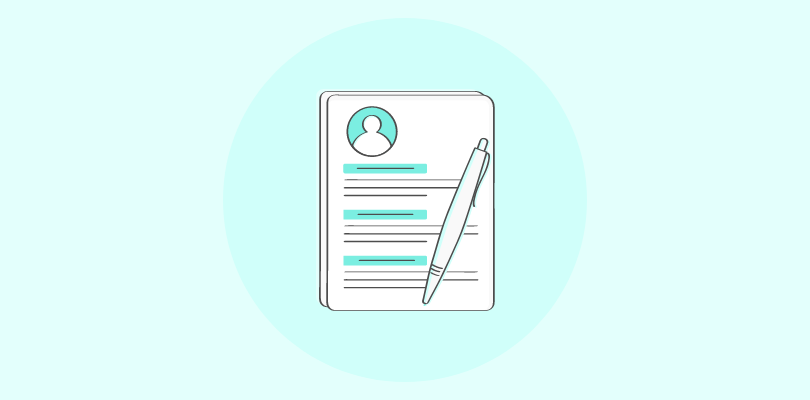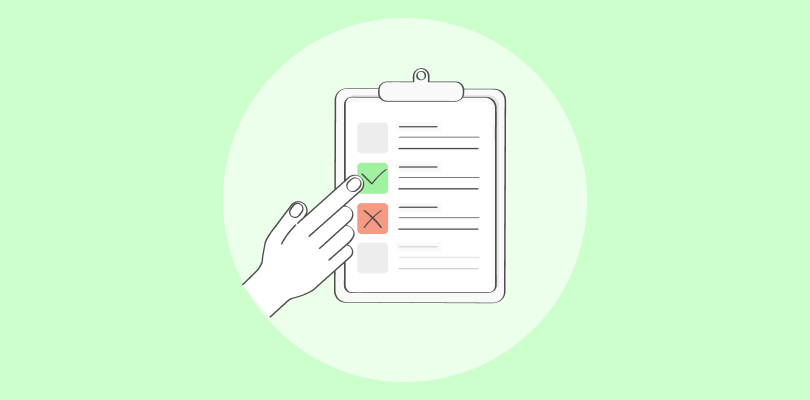If you’ve ever faced the dilemma of asking yourself, ‘Should I give a quiz, a group activity, or something else entirely?’—you’re not alone. Whether you’re teaching a class, running a training program, or hiring new team members, the challenge isn’t deciding if to assess, but how.
The reality is that the different types of assessment aren’t interchangeable. Each one is built for a specific purpose — some surface knowledge gaps, others track growth, and a few predict long-term performance. Confusing them or using them out of sequence leads to missed signals and wasted time.
This guide lays out 16 types of assessment across education, training, and hiring. We’ll explore:
- What they are
- When and where to apply each type
- And what results to expect
If you’re designing a course, evaluating employee progress, or screening candidates, this will help you choose with intent.
Let’s jump in.
3 Main Types of Assessment
1. Diagnostic Assessment/Learning Needs Assessment
A diagnostic assessment gives you a clear picture of what learners already know and what they still need to learn. With that insight, you can personalize your approach—adjusting materials and instruction to fit their needs instead of taking a one-size-fits-all approach.
It’s also a great way to boost engagement. When learners see where they stand and set their own goals, they’re more likely to take ownership of their learning.
In the workplace, diagnostic assessments play a big role in training needs analysis (TNA)—helping companies figure out exactly who needs what kind of training so they can upskill employees efficiently and keep everyone on the same page.
When to Conduct:
Teachers can conduct a diagnostic assessment at the beginning of the academic year, beginning of a unit, beginning of a lesson, etc.
Businesses can conduct diagnostic assessments whenever the organization goes through significant changes requiring employee training, such as creating or restructuring departments, a change in the strategic vision, introducing new business software, succession planning, etc.

Examples of Diagnostic Assessments:
- Skill/knowledge assessment tests
- Interviews
- Employee surveys
- Student self-assessments
- Student reflection: A process in which students actively think about their learning experiences and outcomes
- Classroom discussions
- Graphic organizers, such as concept maps and K-W-L charts (example below)
-
- In-course assessments
-
- Weekly/monthly quizzes
-
- Group projects
-
- Progress reports summarizing learners’ achievements, strengths, weaknesses, challenges, and goals
-
- Classroom discussions
-
- Exit tickets: These are questions teachers ask at the end of a class or lesson to collect feedback and encourage student reflection. The questions are asked via sticky notes or digital mediums and serve as the “ticket to leave”.
-
- Final assessment quiz in a training course
-
- Mid-term or end-term exams
-
- Final project
-
- Unit tests
-
- Standardized tests
-
- Theses or presentations
- Quarterly benchmark tests
- Mid-year standardized assessments
- District or state-level benchmark exams
- Preliminary Scholastic Aptitude Test (PSAT) – A standardized test used to assess college readiness before taking the SAT
- Northwest Evaluation Association Measures of Academic Progress (NWEA MAP) Growth tests – Adaptive assessments that track student progress over time
- Standardized Test for the Assessment of Reading (STAR) Reading and Math assessments – Computer-adaptive tests used periodically to monitor academic growth
-
- Pre- and post-training assessments
- Self-assessment quizzes
- Competency-based evaluations
- Portfolio assessments – Track progress by evaluating a collection of a learner’s work over time.
- Language proficiency progress tests – Measure improvement in speaking, writing, or comprehension skills across multiple assessments.
- Standardized college admissions tests – SAT (Scholastic Aptitude Test) and GRE (Graduate Record Examination)
- IQ tests
- National standardized achievement tests – ACT (American College Testing), NAEP (National Assessment of Educational Progress)
- Aptitude tests – LSAT (Law School Admission Test), MCAT (Medical College Admission Test)
- K-12 standardized tests – TerraNova, Iowa Assessments, Stanford Achievement Test
- Gifted and talented program assessments – Tests used to identify students for advanced learning programs

- Advanced Placement (AP) Exams
- National Assessment of Educational Progress (NAEP)
- Driving tests – Assess knowledge and skills based on set licensing requirements
- Teacher certification exams – Praxis, edTPA, or other state-required assessments
- Industry certification tests – CompTIA, AWS Certification, Microsoft Certified Solutions Expert (MCSE)
- End-of-course exams – Measure mastery of a specific subject based on course objectives
- CPR and first aid certification tests – Assess practical and theoretical knowledge against established medical guidelines
-
- Term papers
- One-on-one discussions
- Observation of learners’ performance in real or simulated situations to assess their skills and competencies
-
- Frequency should be based on the nature of the job/task
-
- Frequency should be based on past performance
-
- Safety awareness assessments
-
- Periodic self-assessments
- Coding and programming tests for software development roles
- Situational judgment tests (SJTs) for evaluating decision-making in the workplace
- Numerical reasoning tests
- Typing proficiency tests for administrative tasks
- Leadership and management skills evaluations
- Watson-Glaser Critical Thinking Appraisal – Measures logical reasoning and decision-making skills.
- Raven’s Progressive Matrices – Assesses abstract reasoning and problem-solving ability.
- SHL General Ability Test – Evaluates numerical, verbal, and logical reasoning skills.
- Wonderlic Personnel Test – Tests cognitive speed, problem-solving, and decision-making.
- Berke Assessment – Measures cognitive agility, adaptability, and reasoning skills.
- Personality assessments focus on inherent traits like extraversion, conscientiousness, or openness, which tend to remain stable over time.
- Behavioral assessments measure how a person reacts to specific situations, which can change based on experience, environment, or training.
- Big Five Personality Test (OCEAN Model) – Measures five core traits: Openness, Conscientiousness, Extraversion, Agreeableness, and Neuroticism.
- DiSC Personality Assessment – Identifies behavioral tendencies in workplace interactions and leadership styles.
- Myers-Briggs Type Indicator (MBTI) – Categorizes individuals into 16 personality types based on how they perceive and interact with the world.
- Emotional Intelligence (EQ) Assessments
-
- Early on in the hiring process for screening candidates
-
- Before, during, or after an employee training program
- Situational judgment tests (SJTs)
- Job simulations for hiring
- Role-playing exercises – Assess problem-solving and interpersonal skills in real time.
- Case study evaluations – Test analytical thinking through real-world business scenarios.
- Crisis management simulations – Evaluate decision-making under pressure, especially for leadership roles.
- Student portfolios showcasing projects and progress
- Capstone projects and research presentations
- Public speaking evaluations
- Hands-on technical assessments (e.g., coding tests, laboratory experiments)
- Workplace simulations (e.g., customer service role-playing, leadership exercises)
- Self-reflection journals after completing a project
- Confidence rating scales for newly learned skills
- Goal-setting worksheets tracking personal progress
- Employee self-reviews before performance evaluations
- Students grading each other’s essays based on a rubric
- Group project evaluations in classrooms or business teams
- 360-degree feedback assessments in the workplace
- Peer review of presentations or creative work
- Diagnostic: Avoid teaching what learners already know
- Formative: Detect and fix confusion before it compounds
- Summative: Confirm retention before moving on
- Refresher: Sustain knowledge after the course ends
- Use skill assessments to verify what candidates can do.
- Use cognitive ability tests to gauge reasoning and learning potential.
- Use personality or behavioral assessments to see how someone might fit into a team or culture.
- Add scenario-based tasks to evaluate how they make decisions under pressure.
-
- Which test questions are commonly missed?
-
- Which topics are difficult to grasp?
-
- What misconceptions do learners have?
-
- How will you use the assessment scores?
-
- What type of data will you gather?
-
- What do you want to achieve with this assessment?
-
- What to study
-
- How to study
-
- How much time to spend on a subject or topic
-
- Well-constructed responses
-
- Use of critical thinking
-
- Identification of skills
-
- Logical reasoning
-
- Practical knowledge
-
- Situational judgment
-
- Add images or videos to your question statements and answer options
-
- Present a video and ask questions based on it
-
- Add a video or image to the welcome screen
-
- Add images to instant question feedback to explain concepts
-
- Add a great-looking background
-
- Customize the fonts and colors
-
- Add your brand logo to the interface
-
- Prevent unauthorized access to your assessment using privacy settings, password protection, and individualized learner logins
-
- Enable proctoring and disallow tab switching
-
- Disable copying and printing of the assessment content
-
- Randomize the order of questions and answer options
- Create a question pool/bank to present different question sets to different assessment takers
-
- Create quizzes and assessments with AI in various ways—by giving a prompt, uploading a document or video, or pasting a link
- Access high-quality readymade assessments, templates, and questions
-
- Conduct cheating-free assessments using security and anti-cheating settings
-
- Set up and manage an automated certification/recertification process
-
- Assess performance and progress in-depth using advanced reporting and analytics
-
- Design engaging assessments featuring interactive question types, multimedia, themes, etc.
Classroom Scenario:
Before starting a unit on volcanoes, a middle school science teacher uses a KWL chart to gauge what students already know. One student writes, “Volcanoes are always dangerous,” which leads the teacher to include a section on dormant volcanoes to correct the misconception.
Workplace Scenario:
Before launching Excel training, an L&D team sends out a quick self-assessment asking employees to rate their comfort level with formulas, pivot tables, and charting. The results reveal most are confident with formulas but need help visualizing data — so the training skips the basics and focuses on chart-building.
| K (What I Know) | W (What I Want to Know) | L (What I Learned) |
|---|---|---|
| Volcanoes are mountains that erupt lava. | How do volcanoes form? | Volcanoes form when magma rises from the Earth’s mantle and breaks through the crust. |
| Volcanoes can cause earthquakes and tsunamis. | What are the different types of volcanoes? | There are different types of volcanoes based on their shape, size, and activity. Some examples are shield, composite, and cinder cone volcanoes. |
| Volcanoes are found near plate boundaries. | How do volcanoes affect the environment and people? | Volcanoes can affect the environment and people in positive and negative ways. They can create fertile soil, new landforms, and geothermal energy. They can also cause air pollution, climate change, and natural disasters. |
Want to put KWL charts to use right away?
How to Use Diagnostic Assessments:
Step 1: Make a diagnostic assessment that covers the learning goals and the prior knowledge of the topic.
Step 2: Give it to your learners and tell them it is for learning, not grading. It will show them and you what they know and need to learn.
Step 3: Check the results and see the strengths and weaknesses of your learners. Find out what they understand, misunderstand, or want to learn more about.
Step 4: Change your instruction based on the results. Skip or review topics as needed. Give different levels of challenge or support to different learners.
Step 5: Use the diagnostic assessment as a guide throughout the topic. Remind your learners of their goals and progress, and help them when they need it.
2. Formative Assessment
Formative assessments are like quick check-ins that help you see how learners are doing while they’re learning—not just at the end. Instead of waiting until it’s too late, you can spot struggles early, clear up confusion, and adjust your approach as needed.
But they’re not just about tracking progress—they also keep learners engaged. When people get regular feedback, they know where they stand, what they need to work on, and how to improve. That kind of clarity makes learning way more effective.
And here’s the best part: feedback goes both ways. You’re not just evaluating learners—they’re also giving you insights. Their answers, reactions, and even direct input can show you what’s working, what’s not, and where they might need extra support. The more you use formative assessments, the better you can fine-tune your teaching or training to fit their needs.
When to Conduct:
The best time for a formative assessment? Whenever it helps keep learning on track. You can use them after introducing a new concept, mid-lesson to see if things are making sense, or at the end of a session to check what needs more attention. Think of them as quick temperature checks—the more often you use them, the easier it is to adjust and keep things moving in the right direction.
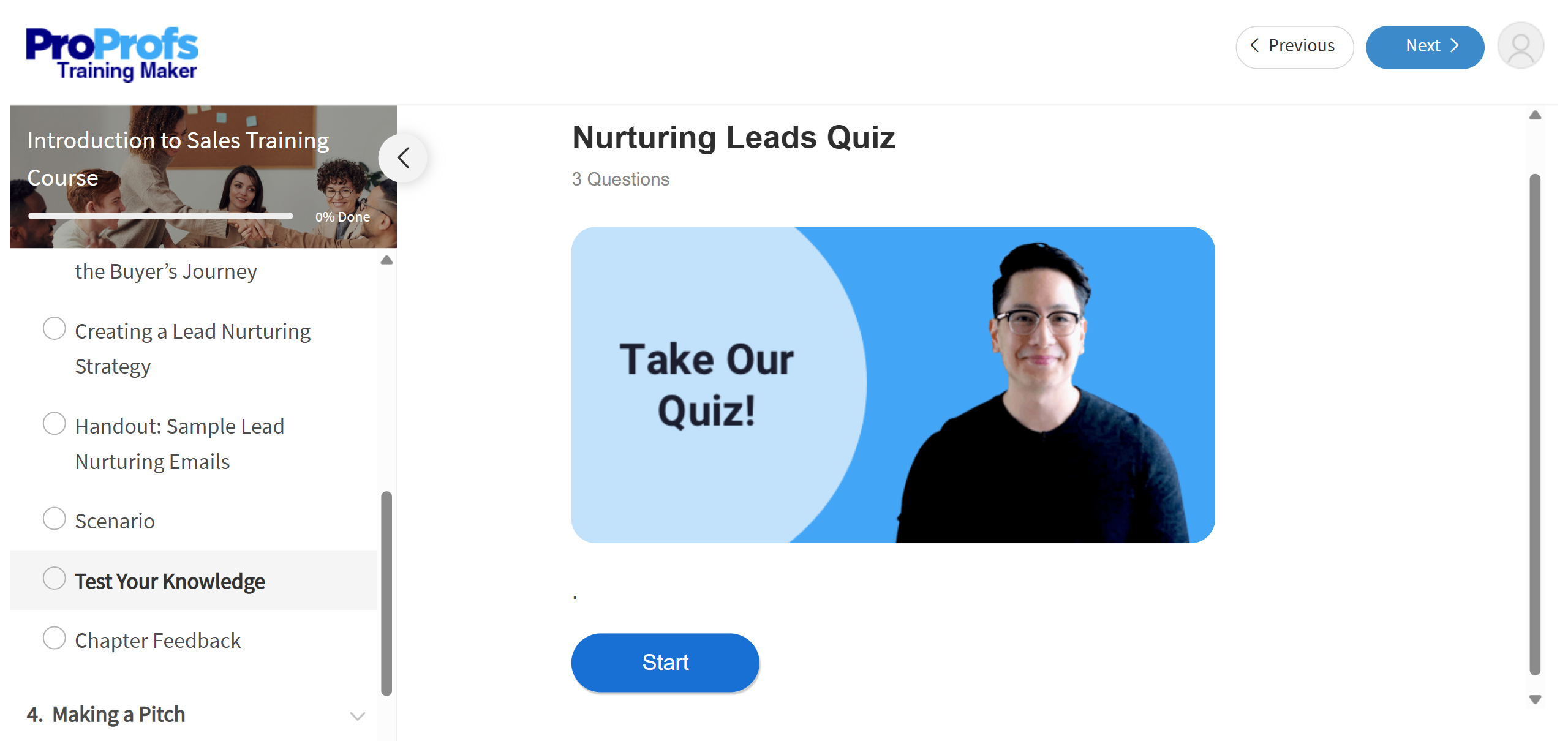
Examples of Formative Assessments:
Classroom Scenario:
After teaching a lesson on photosynthesis, a biology teacher uses a 3-question digital quiz to check comprehension. When most students miss the question on sunlight as an energy source, the teacher pauses the next activity and reviews that concept with a visual model.
Workplace Scenario:
During a remote customer service training, a manager runs a live quiz mid-session. One question about handling an angry caller receives mixed responses, prompting the trainer to initiate a short role-play to reinforce the right approach.
How to Use Formative Assessments:
Step 1: Create your learning program and add formative assessments at key points. For example, teachers can use them after an activity, a class, or a unit.
Step 2: Give the formative assessments to your learners in the format that best suits your requirements.
Step 3: Analyze how your learners are doing. Find out what they understand, misunderstand, or want to learn more about.
Step 4: Provide common and/or personalized feedback to your learners to help them understand where they went wrong, show them how they’re progressing, and guide them in their self-learning.
Step 5: Ask for feedback on your teaching methods and materials from your learners.
Step 6: Adjust your teaching/training based on the learner feedback.
3. Summative Assessment
Summative assessments are like the final scorecard—they measure how well learners have met the learning goals by the end of a unit, course, or program. Comparing these results with diagnostic assessments gives you a clear picture of how effective the learning experience was and what kind of impact it had.
But it’s not just about grading or ticking boxes. These assessments also help you fine-tune your materials and teaching approach for the future. And for learners, they offer a chance to reflect on their progress, see how far they’ve come, and figure out where they can still improve.
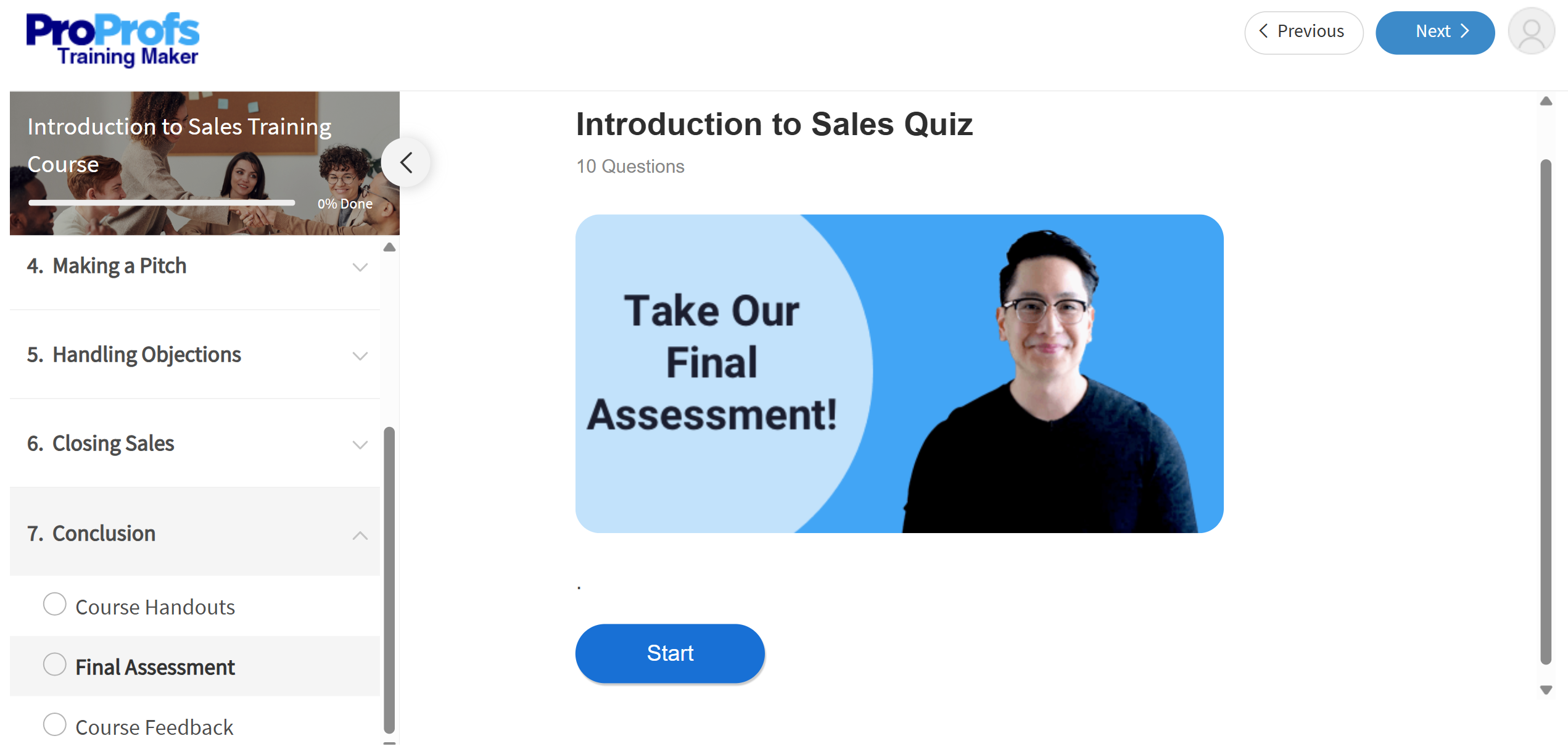
When to Conduct:
Summative assessments work best right after a course or program wraps up while the material is still fresh. Timing is key—too soon, and learners may not have fully processed the content; too late, and retention may fade.
Examples of Summative Assessments:
Classroom Scenario:
At the end of a high school literature course, students present a thematic analysis of a novel. A clear rubric evaluates thesis clarity, use of evidence, and presentation skills. The teacher provides each student with feedback and a reflection prompt to take into their next class.
Workplace Scenario:
After a compliance training program, employees complete a final quiz followed by a short situational task. Scores are recorded, and those who score below 80% are automatically enrolled in a follow-up module to reinforce the material.
How to Use Summative Assessment:
Step 1: Choose an appropriate summative assessment method that matches the learning objectives and the content.
Step 2: Design the assessment questions or tasks to measure the learners’ mastery of the learning objectives. Use a variety of question types or formats to assess different levels of thinking and skills.
Step 3: Conduct the assessment.
Step 4: Evaluate the learners’ performance using a rubric or scoring guide that reflects the learning objectives and the criteria for success.
Step 5: Provide feedback to the learners on their strengths and areas for improvement. Encourage them to review their work and find the right answers.
Step 6: Schedule retakes for those who want a chance to improve their score.
Step 7: Use the assessment results to inform instruction and plan future learning activities. Adjust your teaching strategies or materials based on the learners’ needs and progress.
Other Types of Assessment
4. Interim/Benchmark Assessment
Interim or benchmark assessments are used in educational settings to track student progress at specific intervals—like monthly, quarterly, or mid-year. Think of them as structured checkpoints that help educators see if students are keeping up with learning goals. They provide valuable data on what’s working, where students are struggling, and how teaching strategies might need adjusting.
Unlike formative assessments, which are more like real-time check-ins for day-to-day learning, interim assessments focus on the bigger picture—measuring progress over time rather than making immediate tweaks to instruction.
They also differ from summative assessments, which are typically used for final grading. Instead, interim assessments help predict future performance and guide interventions before it’s too late to make a difference. By reviewing these results, educators can make data-driven decisions to keep students on the right track.
When to Conduct:
At scheduled intervals, such as monthly, quarterly, or mid-year, based on the need to evaluate progress and adjust instruction before summative assessments.
Examples of Interim Assessments:
5. Ipsative Assessment
Ipsative assessments focus on individual growth rather than comparison with peers. They measure progress by evaluating a learner’s current performance against their past results, making them a highly personalized way to track improvement.
Because success is based on self-comparison, these assessments help learners stay motivated by showing how their skills are evolving over time. Instead of meeting an external standard, they work toward personal milestones, reinforcing a mindset of continuous learning.
This approach also allows instructors to tailor feedback and support based on each learner’s unique trajectory, ensuring that progress—not just achievement—is at the center of the learning experience.
When to Conduct:
These assessments are valuable in long-term learning programs, employee training, coaching, and self-assessment scenarios where growth is a key focus.
When to Conduct:
Anytime there’s a need to identify learners’ unique learning challenges and personalize your instruction approach
Examples of Ipsative Assessment:
6. Norm-Referenced Assessment
Norm-referenced assessments show how a learner’s performance stacks up against their peers. Instead of just measuring what someone knows, these assessments rank learners from highest to lowest based on their scores within a specific grade level. The results are compared to a norming group—a group of students who have already taken the test—so scores reflect how a learner performed relative to others, not just in isolation.
For example, if a student scores 80% on a norm-referenced test, it doesn’t just mean they got 80% of the answers right—it means they performed better than 80% of the students in the norming group. These assessments are commonly used for things like standardized testing and college admissions, where the goal is to see how individuals compare to a larger pool of test-takers.
When to Conduct:
Anytime there’s a need to identify learners who may have specific educational needs or shortcomings that require special assistance in terms of learning.
Examples of Norm-Referenced Assessments:
7. Criterion-Referenced Assessment
A criterion-referenced assessment measures how well a learner meets a specific set of standards or learning objectives rather than comparing them to others. Instructors set clear goals—called criteria—at the start of a course, and the assessment checks whether students have mastered the required skills or knowledge.
These assessments help educators see what exactly a learner knows and where they might need extra support. Since success is based on meeting predefined benchmarks, instructors can give targeted feedback on what learners need to improve, making the learning process more structured and goal-focused.
When to Conduct:
When determining a learner’s skill level or knowledge based on predefined performance standards.
Examples of Criterion-Referenced Assessment:

8. Confirmative Assessment
A confirmative assessment is all about checking the long-term impact of a learning program. Instead of testing learners right after a course, it takes place months or even a year later to see how much of the material they still remember.
These assessments don’t just measure retention—they also help determine how effective the course was and whether the teaching or training methods need improvement. By looking at what sticks over time, educators and trainers can fine-tune their approach to make learning more impactful.
When to Conduct:
Several months to a year after a learning program ends to assess knowledge retention, skill application, and training effectiveness.
Examples of Confirmative Assessments:
9. Refresher Assessment
Refresher assessments are pretty similar to confirmative assessments in that both are conducted a while after the end of a learning program.
The difference is that refresher assessments are conducted periodically and are aimed at helping learners boost their knowledge retention instead of only assessing the same.
Refresher assessments are a research-backed tool to improve knowledge recall and overcome the forgetting curve.

Image source: csustan.edu
Moreover, refresher assessments may be even more effective than restudying/retraining for this purpose.
When to Conduct:
You can conduct refresher assessments every month, two months, quarter, etc., after your summative assessment, with the interval depending on your requirements and the course material’s complexity.
For example, learning expert Matthew Tang says this about compliance training refresher assessments:
While more casual and less frequently conducted evaluations may be necessary in lower-risk locations, monthly formal assessments may be more appropriate in high-risk areas. For instance:
Infection control and death rates have a strong correlation in a hospital setting, which is a high-risk environment. People may die if personnel don’t follow compliance requirements.
For this reason, formal assessments should be utilized in conjunction with job aids (such as hand washing signs in restrooms) and management observations to regularly review compliance with infection prevention measures.
To guarantee safe chemical handling and storage, many workplaces that use cleaning products (like a retail store which can be a low-risk area) mandate that all staff members complete annual OSHA training.
For handling chemicals, there are specific guidelines in place for only maintenance personnel. It might not be necessary in this situation to test employees frequently, aside from maintenance personnel.
Monthly assessments and training become essential when a business is addressing recent sexual harassment or injury claims.

Examples of Refresher Assessments:
10. Skill Assessment
Resumes can tell you what someone has done. Interviews can show how they talk about it. But skill assessments reveal whether they can actually do the work. These tests shift the focus from credentials to competence—whether it’s writing clean code, analyzing data, or handling real-world decisions under pressure. They’re especially valuable when stakes are high and roles demand more than just surface-level knowledge. You’re not just hiring faster—you’re hiring with evidence.
When to Conduct:
Early on in the recruitment process for screening candidates or as a part of succession planning.

Examples of Skill Assessments:
11. Cognitive Ability Assessment
When it comes to job performance, cognitive ability can be just as important as technical know-how or soft skills. Cognitive ability assessments measure skills like logical reasoning, numerical analysis, spatial awareness, critical thinking, and problem-solving, helping employers gauge how well someone can process information and make decisions on the job.
Since these skills impact learning speed and adaptability, high cognitive ability often translates to stronger problem-solving, faster training, and better long-term performance.
When to Conduct:
Early on in the recruitment process for screening candidates or as a part of succession planning

Examples of Cognitive Ability Assessments:
12. Personality & Behavioral Assessments
Personality and behavioral assessments help predict how individuals think, communicate, and act in different situations. While they are often grouped together, they serve slightly different purposes:
In the workplace, these psychometric assessments help match candidates to roles, enhance team dynamics, and guide leadership strategies by offering insights into motivation, decision-making, and interpersonal skills. Managers can use them to coach employees effectively and reduce workplace conflicts.
Outside of business, educators use these assessments to understand students’ learning styles and behavioral tendencies, allowing them to create more engaging and personalized learning experiences.
If you’re a teacher, here’s a learning style quiz you can use to assess your students’ preferences.
When to Conduct:
During hiring to assess job fit, onboarding to understand work styles, and employee development to guide growth.

Examples of Personality Assessments:
13. Scenario-Based Assessment
Scenario-based assessments bring learning to life by testing how people apply their knowledge in real or hypothetical situations. Instead of just recalling facts, test-takers have to analyze, decide, and act, making these assessments a powerful tool for both hiring and training.

For employers, they help gauge problem-solving skills, decision-making, and job readiness in a way that traditional tests can’t. In training, they make learning more engaging by immersing learners in realistic scenarios, reinforcing critical thinking, and improving retention.
Whether it’s handling a customer complaint, troubleshooting a technical issue, or leading a team through a challenge, these assessments show how well someone can think on their feet—not just what they know.
When to Conduct:
Examples of Scenario-Based Assessments:
14. Performance-Based (Authentic) Assessment
Some things just can’t be measured with multiple-choice tests. That’s where performance-based (authentic) assessments come in. These assessments focus on real-world applications, requiring learners or employees to demonstrate their skills in practical, hands-on tasks instead of simply answering questions.
Industries like medicine, law enforcement, and even corporate training rely on performance-based assessments to evaluate job readiness.
When to Conduct:
When the goal is to evaluate practical skills rather than theoretical knowledge.
Examples of Performance-Based Assessments:
15. Self-Assessment
Who knows your strengths and weaknesses better than you? Self-assessments give learners the chance to reflect on their own progress, helping them recognize what they’ve mastered and where they still need improvement.
Metacognitive assessments (a structured form of self-assessment) encourage deeper thinking by asking learners to analyze their own learning process. When people actively reflect on their skills, they become more engaged and take ownership of their growth—whether it’s a student tracking their understanding of math concepts or an employee evaluating their leadership abilities.
When to Conduct:
Useful whenever reflection can help improve performance. They’re often used at the end of a project, training session, or evaluation period to encourage personal growth.
Examples of Self-Assessments:
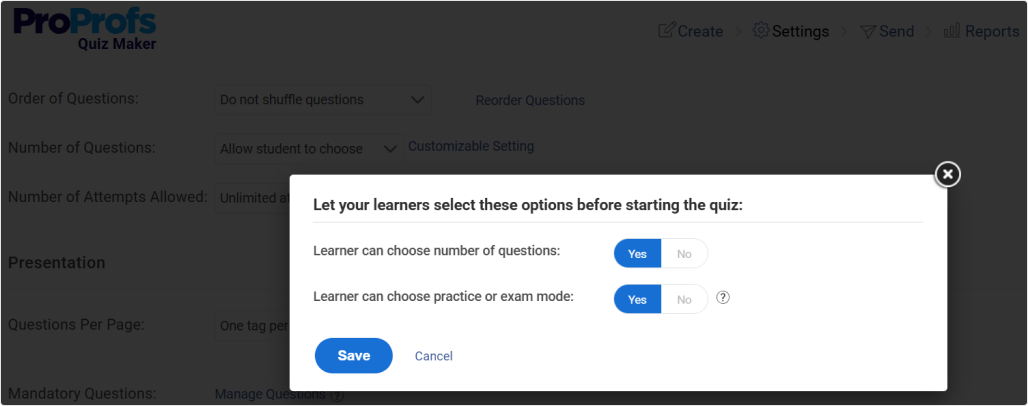
16. Peer Assessment
Instead of just receiving feedback from instructors or managers, learners can also evaluate each other’s work—a process that helps both the reviewer and the reviewee gain deeper insights.
For example, in classrooms, peer grading encourages students to think critically about what makes an answer strong or weak. In corporate settings, 360-degree feedback assessments allow employees to receive well-rounded input from colleagues instead of just their boss.
When to Conduct:
Useful in group projects, writing assignments, presentations, and workplace evaluations.
Examples of Peer Assessments:
At-a-Glance: All Types of Assessment and Their Uses
After exploring each assessment in detail, here’s a handy table that sums up their purpose and best uses at a glance.
| Assessment Type | Purpose | Best Use | Example | Outcome |
|---|---|---|---|---|
| Diagnostic | Identifies learning gaps | Start of a course/training | Pre-course quiz, KWL chart | Customizes instruction and training content |
| Formative | Provides ongoing feedback | Midway through learning | Exit tickets, live quizzes | Real-time adjustments to improve comprehension |
| Summative | Measures final mastery | End of a course/training | Final test, capstone project | Determines if objectives were achieved |
| Norm-Referenced | Ranks test takers against peers | Standardized testing | SAT, GRE | Compares individual to a reference population |
| Criterion-Referenced | Checks mastery of set standards | Certifications, skill tests | CPR test, driving exam | Verifies readiness based on predefined criteria |
| Ipsative | Compares personal progress | Employee coaching, self-improvement | Before/after self-ratings, growth portfolios | Tracks individual growth over time |
| Interim/Benchmark | Tracks progress at set intervals | Monthly/quarterly progress tracking | Mid-year benchmark tests | Flags areas needing support before summative |
| Confirmative | Measures long-term retention | Post-training evaluation | 6-month post-course check-in | Verifies if knowledge is retained and applied |
| Refresher | Reinforces learning to prevent forgetting | Periodic knowledge refreshers | Quarterly compliance quiz | Boosts retention and prevents knowledge decay |
| Performance-Based | Tests real-world skills | Practical training, hiring | Coding task, product demo | Assesses job readiness through demonstration |
| Scenario-Based | Assesses decision-making | Job simulations, leadership training | SJT, crisis simulation | Evaluates application of judgment and reasoning |
| Self-Assessment | Encourages self-reflection | Personal growth, career development | Confidence scale, reflection journal | Promotes metacognition and learner ownership |
| Peer Assessment | Collects feedback from others | Group projects, 360-degree feedback | Peer-reviewed presentation | Builds accountability and critical thinking |
| Skill Assessment | Evaluates job-related skills | Hiring, succession planning | Typing test, task simulation | Validates role-specific capabilities |
| Cognitive Ability | Tests problem-solving & thinking ability | Recruitment, leadership assessments | Abstract reasoning test | Predicts adaptability and learning potential |
| Personality & Behavioral | Assesses personality traits & behavior | Workplace dynamics, team building | Big Five, DiSC assessment | Improves fit, collaboration, and leadership insight |
Now that we’ve explored the various assessment types, let’s look at how they impact learning and decision-making.
Why Use Different Types of Assessment Together?
No single assessment type gives you the full picture. Diagnostic assessments are strong at identifying where learners stand. Formative tools help you adjust your approach. Summative evaluations show what stuck. And skill or scenario-based tests reveal how people apply what they’ve learned in real settings.
Used in isolation, each tool offers a snapshot. Used together, they tell a complete story.
Here’s what you can accomplish by combining the right types at the right time:
1. Shape Smarter Instruction from the Start
Before teaching or training begins, use a diagnostic assessment to surface prior knowledge, misconceptions, or gaps. It helps you avoid teaching what’s already known and focus on what actually needs work.
Then layer in formative assessments—small, low-stakes checks during learning—to refine your strategy as you go. These guide not just the learner, but also you, the instructor.
Tip: Pair a short pre-course quiz with a few weekly pulse checks. You’ll catch blind spots early and keep learners on track without overwhelming them.
2. Make Progress Visible (To Both Sides)
Learners often can’t tell if they’re improving unless you show them. Use formative assessments for ongoing feedback and summative assessments to help them connect their effort to measurable outcomes.
More importantly, compare diagnostic → summative performance to see growth over time—not just final scores.
Action Step: Visualize learning gains. Even a simple “before vs. after” score comparison reinforces progress and motivates learners to keep going.
3. Fine-Tune Your Approach with Real Data
If learners are struggling, is it because the content missed the mark, or the delivery didn’t land? Use formative assessments to collect feedback midstream and analyze summative results to understand where your instruction may be falling short.

Mix in self-assessments and peer assessments to gather additional insights that standard tests often miss.
Quick Win: Build a short post-training survey asking learners where they felt least confident. Map that feedback to assessment results to identify friction points in your course.
4. Reduce Waste in Training Budgets
Training is costly. Ineffective training is even more expensive. Using multiple assessment types across the learning cycle helps avoid this by making your programs more targeted, more responsive, and more measurable.
Try This: Build training plans around the full cycle—diagnose, train, assess, refresh. Tools like ProProfs Training Maker let you automate this flow with pre-built templates and quiz banks.
5. Hire and Promote With More Confidence
In hiring and succession planning, pairing different assessment types reveals far more than a resume or interview ever could.

View Sales Management Skills Assessment
You don’t need to test everything at once. Use lighter assessments upfront to screen, then deeper evaluations later to confirm alignment and potential.
In the next section, we’ll look at how to choose the right mix of assessments for learning goals—and avoid common pitfalls.
FREE. All Features. FOREVER!
Try our Forever FREE account with all premium features!
How to Choose the Best Assessment Type for Learning
You must choose an assessment type that helps evaluate your learners in a way that fits the goals of your instructions.
We’ve shared some tips below to help you choose the best type of assessment:
1. Take Into Account Different Learning Styles
All of your learners’ learning styles vary widely, and the strengths and challenges concerning the assessment vary as well. When choosing an assessment for learning, you must consider that variation.
By taking into account the various learning styles of your learners, you’re more likely to offer equal opportunities to everyone to demonstrate their knowledge.
You can accomplish this by creating different types of assessment tests with different types of questions, for example, multiple-choice questions, image-based questions, hotspot questions, video response questions, essay-type questions, and more.
Watch: Question Types for Online Learning & Assessment
2. Consider Assessment Intervals
Flooding your learners with a series of assessments won’t help you if your learners need only a single assessment.
Consider the frequency with which your learners should be assessed to reach the desired learning outcomes. And while you’re at it, also consider the factors that drive learning, such as your learners’ motivation to learn, attention, and energy level.
Try various intervals, such as weekly, quarterly, and half-yearly, and choose the one that best supports your assessment needs.
3. Match Learning Goals to Assessment
What you assess is what your learners study, are engaged with, and explore in more depth.
Begin with what you want learners to know and be able to do. This way, you can design and choose assessments that will help them demonstrate the appropriate knowledge and skills.
Decide the learning outcomes, and then make a grid. Place the learning outcomes across one axis and the assessment demonstrating their achievement on the other.
Refer to the following table as an example:
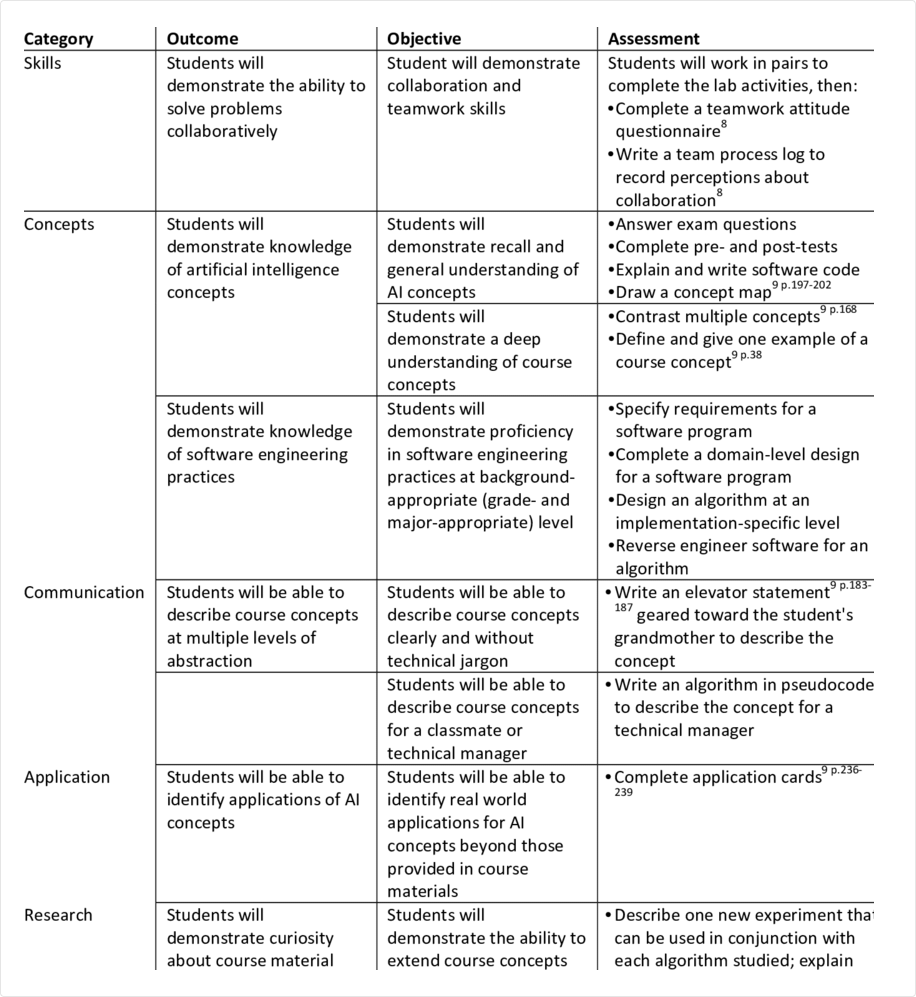
This way, you can double-check to ensure each learning outcome has been assessed.
If you make it clear to learners how each assessment furthers the goals of the instruction, they can make informed choices about how to spend their limited learning time to achieve the course goals.
4. Collect Data on Learners’ Progress
Despite choosing the correct form of assessment and the intervals that best support your assessment needs, there will still be some topics or units of instruction where your learners will fall short.
To find this out, you can try getting the answers to questions such as:
In that case, you can identify weaknesses in instruction and assessment choices and make adjustments as needed.
We know that after choosing an assessment type, you won’t want to wait to get started. But hold that thought, and read our next section for the best online assessment tips!
How to Conduct Online Assessments Effectively: Top Tips
Here are some tips for creating the best assessment tests for education, training, or hiring.
1. Create Clear Rubrics
Rubrics are criteria that paint a picture of the upcoming assessments. Outline the topics and areas you’ll cover in the assessment and specify the grading scheme.
Refer to the following example of a rubric:
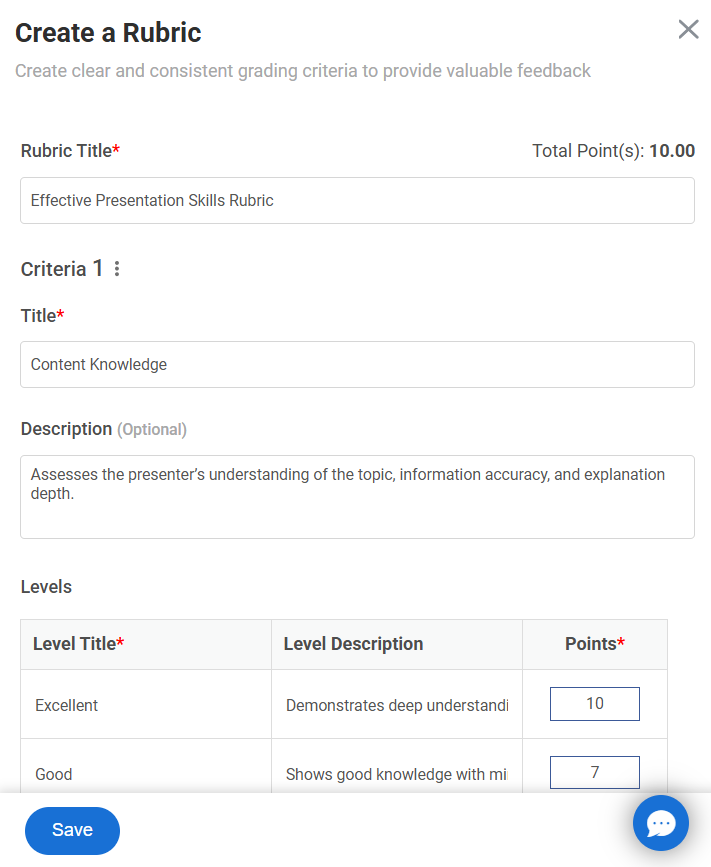
Creating clear rubrics will help create a learning map for your learners to follow and give their best performance.
2. Establish the Purpose of the Assessment
Before you create an assessment, establish a clear purpose. This will ensure you can meet the end goals effectively.
Ask yourself questions such as:
These questions will help find out the length, average difficulty level, and conditions for the assessment you want to create.
3. Support Learning
How learners learn and what they learn can depend greatly on how they think they’ll be assessed. Informing the learners about the assessment practices that you’re going to follow can help them decide:
By telling them what they must do to outshine their peers in an assessment, you can motivate learners to upgrade their self-learning game.
4. Include a Mix of Question Types
If you’re a teacher or trainer, you need to help achieve all your learners’ learning potential. So, include different question types such as hotspot, essay, true/false, image/video-based questions, etc., to create different types of assessment.
Avoid using only the multiple-choice question type. Instead, throw in a good mix of questions that require:
5. Make It Visual
You can add images, videos, and audio clips to your assessment tests to make them more engaging. For example, you can:
Watch: How to Create a Video Quiz
You can also make your assessments more aesthetically pleasing by adding a beautiful theme. And you can customize the various elements of your theme to make it even better. For example, you can:
6. Provide Excellent Feedback
You can provide question-wise feedback shown instantly after a learner submits an answer or personalized feedback after the assessment via text or video.
Question-specific feedback engages learners and lets them understand where they went wrong, while personalized feedback lets you help learners identify their learning challenges and suggest measures to deal with them.

7. Configure Anti-Cheating Settings
Make sure you enable the anti-cheating settings your assessment tool offers so you conduct credible assessments. For example, you need to:
8. Use the Right Assessment Tool
Want to properly implement all the assessment-making best practices and get all the benefits from various forms of assessment? You’ll need top-notch assessment software.
Here’s what you should be able to do with your assessment tool:
Choosing the right assessment tool can save time, improve accuracy, and enhance the learning experience.
The University of Zurich faced a challenge in creating, distributing, and managing assessments efficiently across its courses. They needed a solution that allowed real-time feedback, automated grading, and streamlined exam management.
We got to interview Sven Hoffman, Program Manager at the University of Zurich, to learn how ProProfs Quiz Maker helped them standardize assessments and reduce faculty workload.
See how they transformed their assessments:
Effective Assessments = Better Learning & Hiring Outcomes
Successful online assessment is a never-ending process. You can create many types of assessment for learning or hiring. But, no matter which assessment style you choose, you should keep evaluating your assessments.
Use the data from previous assessments to identify what worked well and what still needs improvement. Also, explore different types of assessment tools available on the web. With the right practices and the best assessment tool, your assessments will continue to become more effective.
So which assessment tool should you use?
Try ProProfs Quiz Maker. It has an intuitive interface and is powered by a library of 1 million+ questions and hundreds of professionally designed assessments, making it the easiest way to create effective assessments for business or education. ProProfs also offers 20+ question types, robust security settings, and AI-powered quiz generation.
Frequently Asked Questions
How can I use multiple assessment types without overwhelming learners?
Use different types strategically, not all at once. Start with a diagnostic check, add brief formative tasks during instruction, and close with a summative assessment. Include refresher or scenario-based assessments only if needed. Mixing types helps personalize learning while keeping pressure low.
Are self and peer assessments actually useful, or just extra work?
They’re effective when structured well. Self-assessments build reflection and accountability. Peer assessments encourage collaboration and critical thinking. Use rubrics or rating scales to guide responses. When integrated into your flow, they can improve learning outcomes without adding unnecessary workload.
What’s the most effective way to assess soft skills like communication or leadership?
Soft skills are best assessed through scenario-based tasks or simulations. Give learners real situations where they must respond, decide, or lead. This shows how they apply skills, not just describe them. Traditional tests rarely capture this nuance.
When should I use norm-referenced versus criterion-referenced assessments?
Use norm-referenced assessments to compare learners against peers, like in standardized testing. Use criterion-referenced assessments to measure performance against a fixed standard, such as passing a certification. Choose based on whether you’re ranking performance or checking for skill mastery.
How do I know if my assessments are actually working?
Look for alignment between assessment scores and real outcomes. Are learners applying what they’ve learned? Use formative data, learner feedback, and diagnostic-to-summative comparisons to check effectiveness. Good assessments should inform decisions, improve performance, and support retention, not just assign grades.


 We'd love your feedback!
We'd love your feedback! Thanks for your feedback!
Thanks for your feedback!


